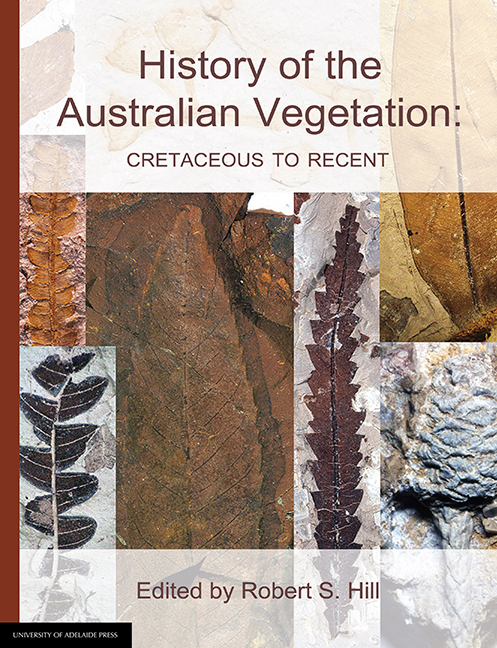Book contents
- Frontmatter
- Contents
- List of contributors
- Introduction to the 2017 edition
- 1 The Australian fossil plant record: an introduction
- 2 Maps of late Mesozoic-Cenozoic Gondwana break-up: some palaeogeographical implications
- 3 The background: 144 million years of Australian palaeoclimate and palaeogeography
- 4 Palaeobotanical evidence for Tertiary climates
- 5 Landscapes of Australia: their nature and evolution
- 6 Patterns in the history of Australia's mammals and inferences about palaeohabitats
- 7 Australian Tertiary phytogeography: evidence from palynology
- 8 Cretaceous vegetation: the microfossil record
- 9 Cretaceous vegetation: the macrofossil record
- 10 Early Tertiary vegetation: evidence from spores and pollen
- 11 The early Tertiary macrofloras of continental Australia
- 12 Cenozoic vegetation in Tasmania: macrofossil evidence
- 13 The Neogene: a period of transition
- 14 The Oligo-Miocene coal floras of southeastern Australia
- 15 Quaternary vegetation
- 16 The history of selected Australian taxa
- Taxonomic index
- General index
6 - Patterns in the history of Australia's mammals and inferences about palaeohabitats
Published online by Cambridge University Press: 25 July 2017
- Frontmatter
- Contents
- List of contributors
- Introduction to the 2017 edition
- 1 The Australian fossil plant record: an introduction
- 2 Maps of late Mesozoic-Cenozoic Gondwana break-up: some palaeogeographical implications
- 3 The background: 144 million years of Australian palaeoclimate and palaeogeography
- 4 Palaeobotanical evidence for Tertiary climates
- 5 Landscapes of Australia: their nature and evolution
- 6 Patterns in the history of Australia's mammals and inferences about palaeohabitats
- 7 Australian Tertiary phytogeography: evidence from palynology
- 8 Cretaceous vegetation: the microfossil record
- 9 Cretaceous vegetation: the macrofossil record
- 10 Early Tertiary vegetation: evidence from spores and pollen
- 11 The early Tertiary macrofloras of continental Australia
- 12 Cenozoic vegetation in Tasmania: macrofossil evidence
- 13 The Neogene: a period of transition
- 14 The Oligo-Miocene coal floras of southeastern Australia
- 15 Quaternary vegetation
- 16 The history of selected Australian taxa
- Taxonomic index
- General index
Summary
During the last two decades, vertebrate palaeontological research in Australia has entered a new phase of development, with more investigators backed by a significant increase in financial support from government and private financial sources. The consequences of this accelerated phase of investigation has been rapid growth in information about vertebrate diversity, phylogenetic relationships, biocorrelation, palaeobiogeography and palaeoecology. In this review, we consider highlights of the developing late Mesozoic- late Cenozoic record of Australian terrestrial mammals, in part because the Cenozoic record of these is better known than that for any other group of vertebrates and in part because the ability to infer aspects of palaeohabitats from anatomical features is perhaps greatest for this group.
Most modern orders of mammals underwent adaptive radiations between the Late Cretaceous and late Paleogene subsequent to the Early to mid-Cretaceous diversification of angiosperms. For this reason many aspects of the history and structure of Australia's mammalian herbivores reflect the requirements of harvesting and consuming particular groups of flowering plants. In so far as this correlation holds, it is possible to infer from the structure of the dentition of extinct herbivores aspects of the vegetation upon which they fed. Although experimental studies (e.g. Sanson, 1989) of the function of the teeth of living Australian herbivores are few, deductive analysis of the diets of extinct forms based on diets of living species enables hypotheses about the timing of key mid-late Tertiary changes in the structure of Australia's terrestrial communities.
Higher-level systematic nomenclatures used here follow those of Aplin & Archer (1987; marsupials), Watts & Aslin (1981; rodents) and Walton & Richardson (1989; bats and other mammal groups). Biostratigraphic nomenclature, unless otherwise indicated, follows those of Woodburne et al. (1985) and Archer et al. (1989, 1991). The positions of the major fossil sites discussed in this chapter are shown in Figure 6.1 and the current understanding of the ages of the sites is shown in Figure 6.2.
AUSTRALIAN MAMMAL DIVERSITY
There are 12 groups of ordinally distinct endemic Australian mammals.
- Type
- Chapter
- Information
- History of the Australian VegetationCretaceous to Recent, pp. 80 - 103Publisher: The University of Adelaide PressPrint publication year: 2017



